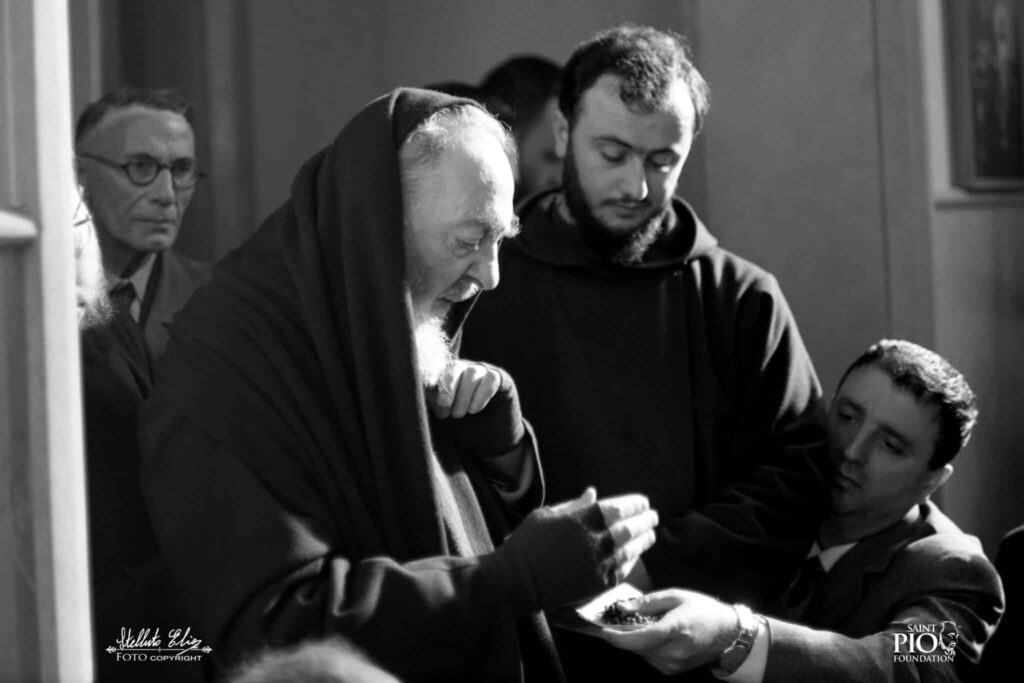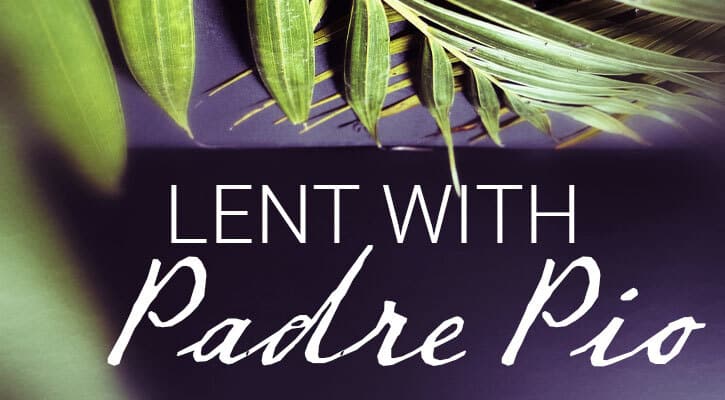
I know many people, especially young people, who pray to God every day through Padre Pio and with Padre Pio. They still think of him as “Padre,” even though he has been “St. Pio” of Pietrelcina for some years now. And these people—many in Italy but even more outside Italy—turn to the stigmatic of Gargano on the most ordinary occasions and in the most ordinary circumstances of their daily lives, exhibiting a devotion that manifests itself in several forms: carrying a picture of him in their wallets to show whoever asks them about their faith; displaying his photograph in shops along the superhighways of Italy; and reading extracts from his incomparable letters that have now been collected in volumes.
Enjoy these resources on Padre Pio, Capuchin Franciscan, servant of God, and heavenly saint…

Saint of the Day: Pio of Pietrelcina
In one of the largest such ceremonies in history, Pope John Paul II canonized Padre Pio of Pietrelcina on June 16, 2002. It was the 45th canonization ceremony in Pope John Paul’s pontificate. More than 300,000 people braved blistering heat as they filled St. Peter’s Square and nearby streets. They heard the Holy Father praise the new saint for his prayer and charity.
“This is the most concrete synthesis of Padre Pio’s teaching,” said the pope. He also stressed Padre Pio’s witness to the power of suffering. If accepted with love, the Holy Father stressed, such suffering can lead to “a privileged path of sanctity.” Read our Saint of the Day entry for Padre Pio.

A Saint for All Seasons
Today, visitors can see Padre Pio in repose in a golden crypt in the Padre Pio Pilgrimage Church. He is dressed in his brown Capuchin habit with a white silk stole embroidered with crystals and golden thread. In his hands, he holds a large wooden cross, a symbol of not only his devotion to God, but also the stigmata by which he was known.
Here he rests, but the message he spread in life continues to enrapture the world. Padre Pio, the living saint, will forevermore be St. Pio of Pietrelcina. Read more about Padre Pio here.

Padre Pio and the Madonna
Padre Pio nurtured his love for the Mother of Jesus from the time he was a child. He would go to the church in Pietrelcina to greet and to pray to Our Lady of Graces.
He always kept a little picture of this Madonna hanging on the wall of his cell. He would glance up at her with gratitude before eating his meager meals, before going to rest, and each time he returned to his cell weary and fatigued after hearing confessions. He was to look up at his little Mother with immense tenderness before closing his eyes in death. Read more about Padre Pio and the Virgin Mary.

Capturing Padre Pio
I first met Padre Pio in 1967, the year before his death. He was old and very ill. As a journalist, I went to his home in San Giovanni Rotondo on assignment, and I had the opportunity to speak with him on two occasions. I was extremely impressed, not so much by the stories of miracles that people told about him but by the extraordinary moral strength that emanated from his whole being.
It was hard for me to watch him walking in the sacristy or the corridors of the monastery, bent over, dragging his swollen feet, and holding on to the walls so that he would not fall down. Read more about Padre Pio.

My Visit to Padre Pio’s Tomb
A few years ago, 14 pilgrims and I visited the tomb of Saint Padre Pio in San Giovanni Rotondo in southern Italy. In this small town on a barren mountainside, Padre Pio in 1917 began an assignment at the Capuchin Friary and Church of Our Lady of Grace. There he remained until his death on September 23, 1968.
During those decades, many dramatic things happened at that Franciscan friary and church. On September 20, 1918, Padre Pio received the stigmata while making his thanksgiving after Mass in front of a crucifix in the friary choir loft overlooking the inside of the church. Read more about this writer’s visit to Pio’s tomb.

A Look Back at the Life of Padre Pio
Toward the end of the book, the writer, Francesco Napolitano, expresses the hope that the official request for the opening of Padre Pio’s cause for canonization in November 1969 would bear fruit. The cause for his beatification progressed fairly rapidly as the prayer groups that he set up to pray for an end to war, following a request of his namesake, Pope Pius XII, marshaled their troops to ask God to make Pio a saint. And so it was that the Venerable Padre Pio of Pietrelcina was beatified in 1999 by Pope John Paul II, who then canonized Saint Pio of Pietrelcina in June 2002.
This book tells the story of his life, beginning with a boy in rural Pietrelcina named Francesco Forgione, who never realized that the mystical experiences he had were not shared by others. Read more about the holy life of Padre Pio.

The Franciscan Saints: Padre Pio
Padre Pio, a Capuchin friar of peasant background, spent virtually his entire life in a monastery in southern Italy. In most respects he was indistinguishable from his fellow friars. But for some mysterious purpose, Padre Pio was set apart. For the thousands of pilgrims who flocked to hear him say Mass, or to have him hear their confessions, or simply to rest their gaze on his bandaged hands, he was living proof for the existence of God.
Like his spiritual father St. Francis, Padre Pio was a stigmatic; he bore on his hands, feet, and side the wounds of Christ. Read more about this beloved Franciscan.

Shop Our Padre Pio Collection!
Padre Pio is known for his spiritual wisdom, his focus on God’s merciful love, and on loving Jesus above everything. No wonder he is one of the most-loved of all the saints! Learn more about his life, his example, and his inspiring words. See how the spiritual direction he offers might be of use on your own path. Learn more.






